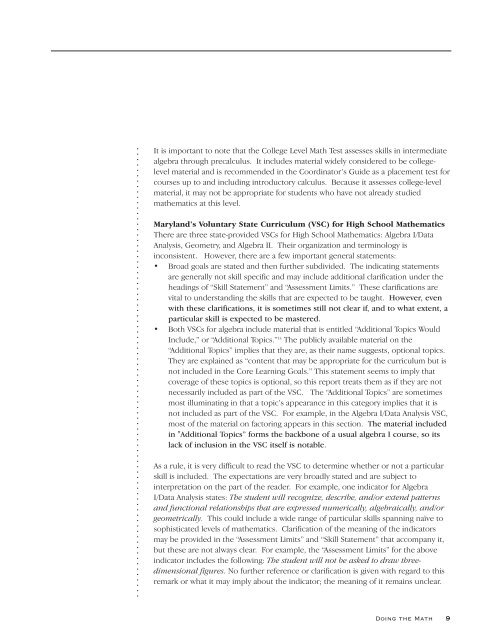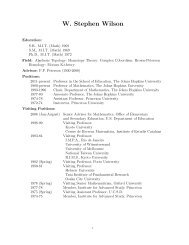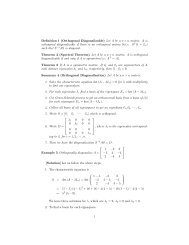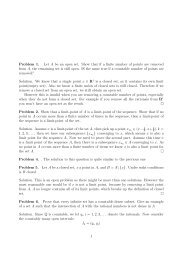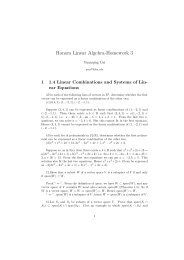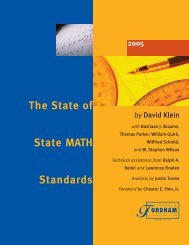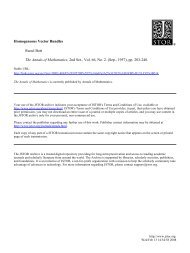Doing the Math - JHU Mathematics - Johns Hopkins University
Doing the Math - JHU Mathematics - Johns Hopkins University
Doing the Math - JHU Mathematics - Johns Hopkins University
You also want an ePaper? Increase the reach of your titles
YUMPU automatically turns print PDFs into web optimized ePapers that Google loves.
. . . . . . . . . . . . . . . . . . . . . . . . . . . . . . . . . . . . . . . . . . . . . . . . . . . . . . . . . . . . . . . . . . . . . . . . . . . . . . . . . . . .<br />
It is important to note that <strong>the</strong> College Level <strong>Math</strong> Test assesses skills in intermediate<br />
algebra through precalculus. It includes material widely considered to be collegelevel<br />
material and is recommended in <strong>the</strong> Coordinator’s Guide as a placement test for<br />
courses up to and including introductory calculus. Because it assesses college-level<br />
material, it may not be appropriate for students who have not already studied<br />
ma<strong>the</strong>matics at this level.<br />
Maryland’s Voluntary State Curriculum (VSC) for High School Ma<strong>the</strong>matics<br />
There are three state-provided VSCs for High School Ma<strong>the</strong>matics: Algebra I/Data<br />
Analysis, Geometry, and Algebra II. Their organization and terminology is<br />
inconsistent. However, <strong>the</strong>re are a few important general statements:<br />
• Broad goals are stated and <strong>the</strong>n fur<strong>the</strong>r subdivided. The indicating statements<br />
are generally not skill specific and may include additional clarification under <strong>the</strong><br />
headings of “Skill Statement” and “Assessment Limits.” These clarifications are<br />
vital to understanding <strong>the</strong> skills that are expected to be taught. However, even<br />
with <strong>the</strong>se clarifications, it is sometimes still not clear if, and to what extent, a<br />
particular skill is expected to be mastered.<br />
• Both VSCs for algebra include material that is entitled “Additional Topics Would<br />
Include,” or “Additional Topics.” 14 The publicly available material on <strong>the</strong><br />
“Additional Topics” implies that <strong>the</strong>y are, as <strong>the</strong>ir name suggests, optional topics.<br />
They are explained as “content that may be appropriate for <strong>the</strong> curriculum but is<br />
not included in <strong>the</strong> Core Learning Goals.” This statement seems to imply that<br />
coverage of <strong>the</strong>se topics is optional, so this report treats <strong>the</strong>m as if <strong>the</strong>y are not<br />
necessarily included as part of <strong>the</strong> VSC. The “Additional Topics” are sometimes<br />
most illuminating in that a topic’s appearance in this category implies that it is<br />
not included as part of <strong>the</strong> VSC. For example, in <strong>the</strong> Algebra I/Data Analysis VSC,<br />
most of <strong>the</strong> material on factoring appears in this section. The material included<br />
in "Additional Topics” forms <strong>the</strong> backbone of a usual algebra I course, so its<br />
lack of inclusion in <strong>the</strong> VSC itself is notable.<br />
As a rule, it is very difficult to read <strong>the</strong> VSC to determine whe<strong>the</strong>r or not a particular<br />
skill is included. The expectations are very broadly stated and are subject to<br />
interpretation on <strong>the</strong> part of <strong>the</strong> reader. For example, one indicator for Algebra<br />
I/Data Analysis states: The student will recognize, describe, and/or extend patterns<br />
and functional relationships that are expressed numerically, algebraically, and/or<br />
geometrically. This could include a wide range of particular skills spanning naïve to<br />
sophisticated levels of ma<strong>the</strong>matics. Clarification of <strong>the</strong> meaning of <strong>the</strong> indicators<br />
may be provided in <strong>the</strong> “Assessment Limits” and “Skill Statement” that accompany it,<br />
but <strong>the</strong>se are not always clear. For example, <strong>the</strong> “Assessment Limits” for <strong>the</strong> above<br />
indicator includes <strong>the</strong> following: The student will not be asked to draw threedimensional<br />
figures. No fur<strong>the</strong>r reference or clarification is given with regard to this<br />
remark or what it may imply about <strong>the</strong> indicator; <strong>the</strong> meaning of it remains unclear.<br />
<strong>Doing</strong> <strong>the</strong> <strong>Math</strong> 9


